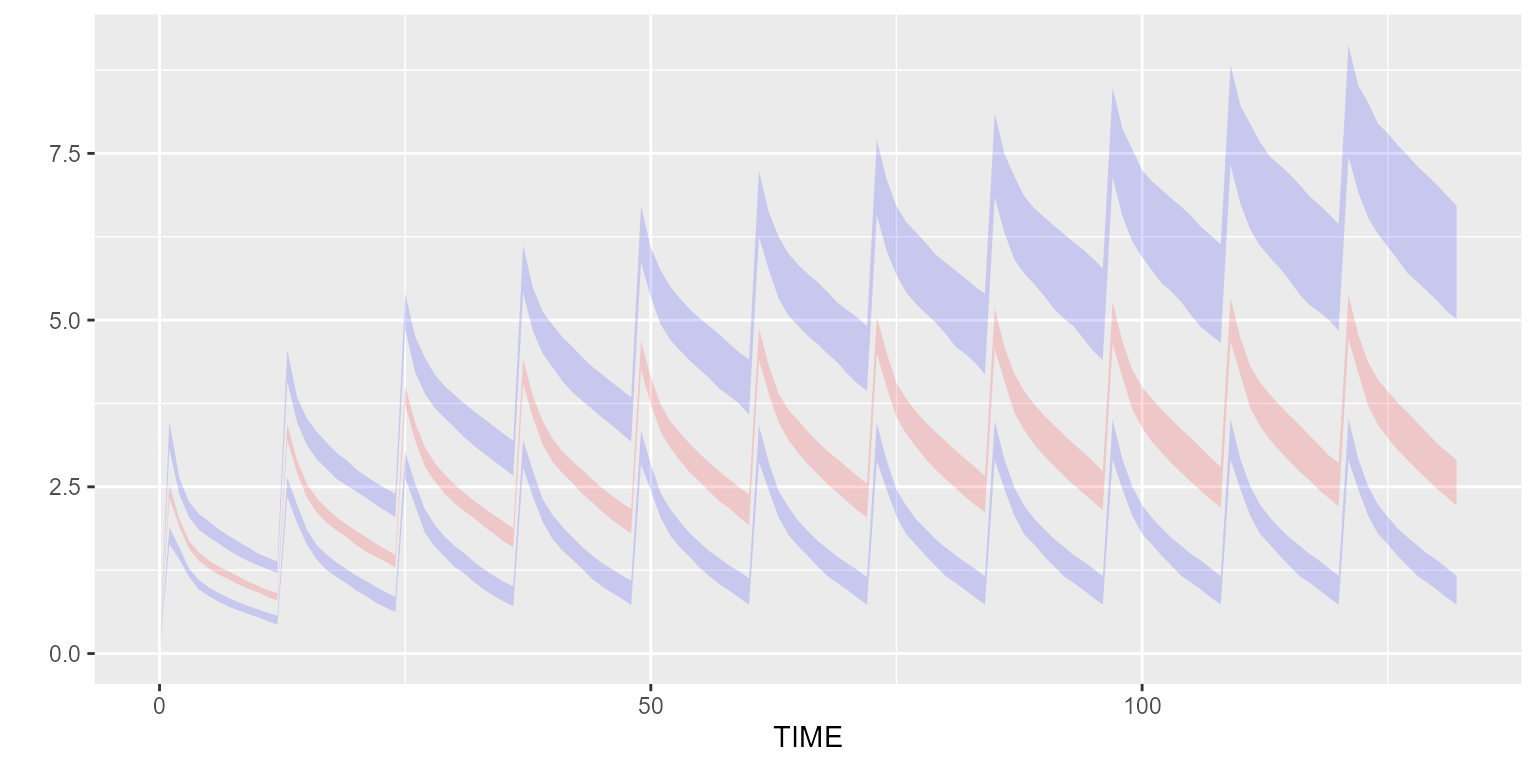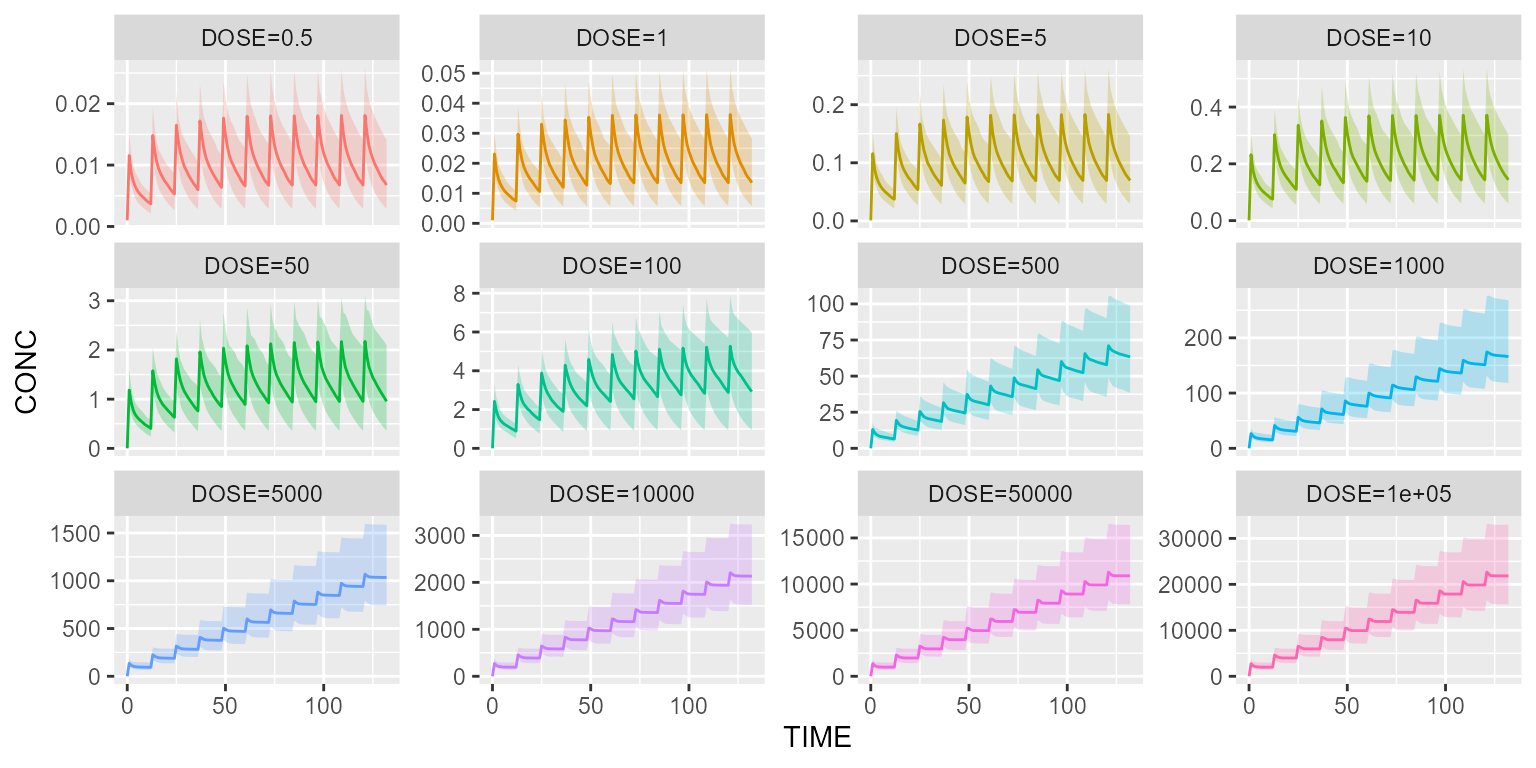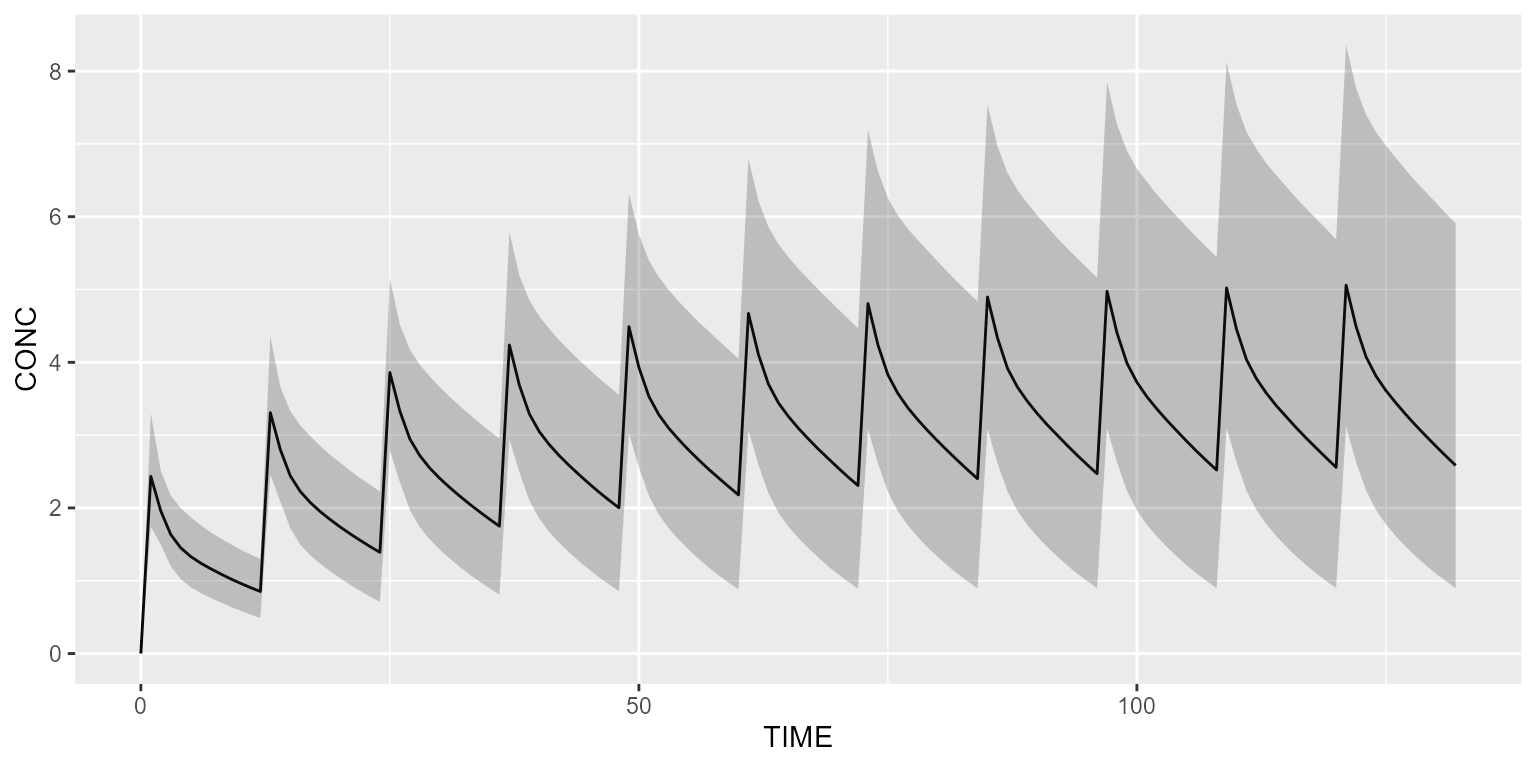
Run your simulation in parallel
Source:vignettes/v17_run_simulation_in_parallel.Rmd
v17_run_simulation_in_parallel.RmdThis vignette explains how Campsis can benefit from several CPU cores for running your simulation efficiently.
Run replicates in parallel
Sequential run:
tic()
results <- simulate(model=model, dataset=dataset, dest="mrgsolve", seed=1, outfun=~PI(.x, output="CONC"), replicates=100)
toc()## 99.378 sec elapsedUsing 6 cores:
tic()
results <- simulate(model=model, dataset=dataset, dest="mrgsolve", seed=1, outfun=~PI(.x, output="CONC"), replicates=10, settings=settings)
toc()## 11.803 sec elapsed
vpcPlot(results)
Since there is no uncertainty on the parameters and since 1000 patients are simulated in each replicate, the confidence intervals on the percentiles are very low.
Run scenarios in parallel
Instead of giving a fixed dose, let’s make the dose dynamic using a DOSE covariate:
Let’s create one scenario per dose to be tested:
scenarios <- Scenarios()
for (dose in c(0.5,1,5,10,50,100,500,1000,5000,10000,50000,100000)) {
scenarios <- scenarios %>%
add(Scenario(name=paste0("DOSE=", dose), dataset=dataset_ %>% replace(Covariate("DOSE", dose))))
}Sequential run:
tic()
results <- simulate(model=model, dataset=dataset_, dest="mrgsolve", seed=1, scenarios=scenarios)
toc()## 15.137 sec elapsedUsing 6 cores (plan is auto-setup):
tic()
results <- simulate(model=model, dataset=dataset_, dest="mrgsolve", seed=1, scenarios=scenarios, settings=settings)
toc()## 12.532 sec elapsedUsing 6 cores (plan already setup from last execution):
tic()
results <- simulate(model=model, dataset=dataset_, dest="mrgsolve", seed=1, scenarios=scenarios, settings=settings)
toc()## 5.952 sec elapsedPlot results:
# Re-arrange scenarios by natural order
results <- results %>% mutate(SCENARIO=factor(SCENARIO, levels=unique(SCENARIO)))
shadedPlot(results, "CONC", "SCENARIO") +
facet_wrap(~SCENARIO, ncol=4, scales="free_y") +
guides(colour="none", fill="none")
Export dataset in parallel
In some particular cases, when the number of subjects is important and/or the dataset is complex, it may be interesting to export the dataset in parallel. Let’s illustrate this feature using a dataset that contains a lot of subjects and treatment IOV (which is costly).
dataset_ <- dataset %>%
setSubjects(24000) %>%
add(IOV("IOV_KA", distribution=NormalDistribution(mean=0, sd=0.1))) # This step is costly
model_ <- model %>%
replaceAll("ETA_KA", "ETA_KA + IOV_KA")Sequential run:
tic()
settings <- Settings(Hardware(slice_size=4000))
results <- simulate(model=model_, dataset=dataset_, dest="mrgsolve", seed=1, settings=settings)
toc()## 35.311 sec elapsedUsing 6 cores (plan is auto-setup):
settings <- Settings(Hardware(cpu=6, dataset_parallel=TRUE, dataset_slice_size=4000, slice_size=4000))
tic()
results <- simulate(model=model_, dataset=dataset_, dest="mrgsolve", seed=1, settings=settings)
toc()## 32.105 sec elapsedUsing 6 cores (plan already setup from last execution):
settings <- Settings(Hardware(cpu=6, dataset_parallel=TRUE, dataset_slice_size=4000, slice_size=4000, auto_setup_plan=FALSE))
tic()
results <- simulate(model=model_, dataset=dataset_, dest="mrgsolve", seed=1, settings=settings)
toc()## 21.636 sec elapsedPlot results:
shadedPlot(results, "CONC")
Run slices in parallel
It may be useful to simulate slices in parallel when the simulation time per individual is high (e.g. long simulation). To illustrate this topic, let’s dose and observe a drug over a 6-month period.
dataset_ <- Dataset(200) %>%
add(Bolus(time=0, amount=100, ii=12, addl=364)) %>%
add(Observations(times=0:(365*12)))Sequential run (rxode2) :
tic()
results <- simulate(model=model, dataset=dataset_, dest="rxode2", seed=1)
toc()## 70.669 sec elapsedSequential run (mrgsolve) :
tic()
results <- simulate(model=model, dataset=dataset_, dest="mrgsolve", seed=1)
toc()## 6.103 sec elapsedUsing 6 cores (rxode2, plan is auto-setup):
tic()
results <- simulate(model=model, dataset=dataset_, dest="rxode2", seed=1, settings=settings)
toc()## 38.246 sec elapsedUsing 6 cores (mrgsolve, plan is auto-setup):
tic()
results <- simulate(model=model, dataset=dataset_, dest="mrgsolve", seed=1, settings=settings)
toc()## 8.737 sec elapsedPlease note that the default slice size for mrgsolve is 500, which means that only 1 core was used in the previous example. For rxode2, which works with a much smaller slice size of 6 subjects, paralleling slices may be interesting for long simulations, as demonstrated here.
Setup plan with package future
As you may have seen in the examples above, the argument auto_setup_plan is TRUE by default. This means, that Campsis, will setup your hardware plan every time you call the simulate method. This comes at a high cost since the setup phase can take some time.
For repeated simulations, it may be useful to setup your plan manually once for all. To do so, you can call setupPlanDefault on your settings or hardware object:
settings <- Settings(Hardware(cpu=2, replicate_parallel=TRUE, auto_setup_plan=FALSE))
setupPlanDefault(settings)If you do so, please don’t forget to set the argument auto_setup_plan to FALSE, when you give these settings to the simulate method, otherwise your plan is setup again…
For going back to the sequential execution (1 CPU core), you can call:
Run Campsis in parallel within the pipeline tool targets
The targets package is a Make-like pipeline tool for Statistics and data science in R. With targets, you can maintain a reproducible workflow without repeating yourself. It is the ideal pipeline tool to use for medium to large simulation projects with Campsis.
This package supports parallelisation and therefore can complete your simulation workflow faster. The following script (_targets.R) gives you a brief overview of how you can run several simulation targets in parallel.
library(targets)
source("R/my_script.R")
# Packages loaded by targets
packages <- c("campsis", "progressr", "future")
tar_option_set(packages=packages, storage="worker", retrieval="worker")
# Prepare 3 workers
future::plan(future::multisession, workers=3)
list(
tar_target(
model,
model_suite$pk$`1cpt_zo_abs_lag`,
deployment="main"
),
tar_target(
dataset,
makeDataset(subjects=1000, dose=1000),
deployment="main"
),
tar_target(
results1,
runSimulation(model=model, dataset=dataset, replicates=10, seed=1),
deployment="worker"
),
tar_target(
results2,
runSimulation(model=model, dataset=dataset, replicates=10, seed=2),
deployment="worker"
),
tar_target(
results3,
runSimulation(model=model, dataset=dataset, replicates=10, seed=3),
deployment="worker"
)
)This small project can be downloaded by clicking the link below.
Download targets squelettonTo run this project, nothing is easier. Open an R console within your targets folder and type:
library(targets)
tar_make_future(workers=3)